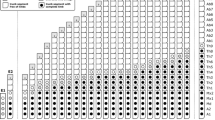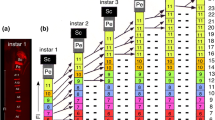Summary
-
1.
The embryonic development of the abdominal cerci of the house cricketAcheta domesticus is described from scanning and transmission electron microscope data.
-
2.
A staged description of externally visible events in embryogenesis is tabulated as a context for describing the chronology of embryonic development of the abdominal cerci.
-
3.
Three phases of cercal development are distinguished: differentiation of the cercal anlagen and secretion of the first embryonic cuticle; elongation of the cercus culminating in the secretion of the second embryonic cuticle after completion of a continuous epidermis at the time of dorsal closure; and differentiation of functional sensilla on the third embryonic (first instar) cuticle.
-
4.
The first axon profiles appear in the cercus immediately before elongation of the cercus. These axons have dendrites with ciliary configuration in the lumen of the cercus. Glial cells associated with the pioneer axons may precede the axons in occupying dorsal and ventral luminal midlines of the cerci.
-
5.
Trichoid sensilla appear in the integumet following apolysis of the second embryonic cuticle.
-
6.
Axons are added to the dorsal and ventral pioneer fibre bundles shortly before sensilla become apparent.
-
7.
The majority of sensory axons traverse the cercus during the final 15% of embryonic development.
-
8.
The sensilla of the first instar cercus do not achieve their final orientation until the cercal cuticle is expanded following eclosion from the second embryonic cuticle that encloses the hatchling until it reaches a free surface.
-
9.
The role of the pioneer fibres in establishing a pathway for the functional sensillar neurons is discussed in relation to other studies of sensillar development in insects.
Similar content being viewed by others
References
Anderson, D.T.: The development of hemimetabolous insects. In: Developmental Systems: InsectsI. (S.J. Counce and C.H. Waddington, eds.), pp. 95–163 London-New York: Academic Press 1973
Ashhurst, D.E.: The connective tissue sheath of the locust nervous system: its development in the embryo. Quart. J. Microsc. Sci.106, 61–73 (1965)
Barbier, R.: Differenication de structures et mise en place des canoux au cours de l'organogenes des glandes colleteriques deGalleria mellonella L. (lepidoptere, pyralide). J. Microsc.24, 315–326 (1975)
Bate, C.M.: Pioneer neurones in an insect embryo. Nature260, 54–56 (1976)
Belling, J.: The iron-acetocarmine method of fixing and retaining chromosomes. Biol. Bull., Woods Hole50, 160–162 (1936)
Berry, S.J., Johnosn, E.: Formation of temporary flagellar structures during insect organogenesis. J. Cell Biol.65, 489–492 (1975)
Caveney, S., Podgorski, C.: Intercellular communication in a positional field. Ultrastructural correlates and tracer analysis of communication between insect epidermal cells. Cell Tiss. Res.7, 559–574 (1975)
Counce, S.J.: The causal analysis of insect embryogenesis. In: Developmental Systems: Insects. (S.J. Counce and C.M. Waddington, eds.), Vol. 2 pp. 1–156 London-New York: Academic Press 1972
Edwards, J.S.: Pathfinding by arthropod sensory nerves. In: Identified Neurons and Behavior of Arthropods (G. Hoyle ed.), pp. 483–493 New York-London: Plenum Press 1977
Edwards, J.S., Milner, M., Chen, S.-W.: Intergument and sensory nerve differentiation ofDrosophila leg and wing imaginal discs in vitro. Wilhelm Roux's Archives185, 59–77 (1978)
Edwards, J.S., Palka, J.: The cerci and abdominal giant fibres of the house cricketAcheta domesticus. I. Anatomy and physiology of normal adults. Proc. Roy. Soc. London, B.,185, 83–103 (1974)
Edwards, J.S., Palka, J.: Neural generation and regeneration in insects. In: Simpler Networks and Behavior (J. C. Fentress, ed.), pp. 167–185. Massachusetts: Sinauer Sunderland 1976
Fristrom, D.: The mechanism of evagination of imaginal discs ofDrosophila melanogaster III. Evidence for cell rearrangement. Dev. Biol.54, 163–171 (1976)
Harrison, R.G.: The origin and development of the nervous system studied by the methods of experimental embryology. The Croonian Lecture Proc. Roy. Soc. London, B.118, 155–196 (1935)
Lauga, J.: Table chronologique du developpement embryonnaire deAcheta domesticus L. (orthoptere, gryllidae). Ann. Sci. Nat. Zool., Paris11, 483–504 (1969)
Louvet, J.-P.: Observation en microscopie electronique des cuticles edifees par l'embryon, et discussion du concept de “mue embryonnaire” dans le cas du phasmeCarausius morosus Br. (Insecta, Phasmida). Z. Morph. Tiere 159–170 (1974)
Matsumoto, S.G., Murphey, R.K.: The cercus to giant-interneuron system of crickets. IV. Patterns of connectivity between receptors and the Medial Giant Interneuron. J. Comp. Physiol.119, 319–330 (1977)
Mclean, M., Edwards, J.S.: Target discrimination in regenerating insect sensory nerve. J. Embryol. Exp. Morphol.36, 19–39 (1976)
Murphey, R.K., Mendenhall, B., Palka, J., Edwards, J.S.: Deafferentation slows the growth of specific dendrites on identified giant interneurons. J. Comp. Neurol.159, 407–418 (1975)
Murphey, R.K., Palka, J., Hustert, R.: The cercus-to-giant interneuron system of crickets. II. Response characteristics of two giant inerneurons. J. Comp. Physiol.119, 285–300 (1977)
Palka, J.: Theories of pattern formation in insect neural development. In: Advances in Insect Physiology (J. Treherne, V.B. Wigglesworth, and M. Berridge eds.) (in press) London, New York: Academic Press (1979)
Palka, J., Edwards, J.S.: The cerci and abdominal giant fibres of the house cricketAcheta domesticus. II. Regeneration and effects of chronic deprivation. Proc. Roy. Soc. London, B.185, 105–121 (1974)
Palka, J., Schubiger, M.: Central connections of receptors on rotated and exchanged cerci of crickets. Proc. Natl. Acad. Sci., USA72, 966–969 (1975)
Panov, A.A.: Correlation in the ontogenetic development of the central nervous system in the house cricketGryllus domesticus L. and the mole cricketGryllotalpa gryllotalpa L. (Orthoptera, Grylloidea). (English translation). Ent. Rev.45, 179–185 (1964)
Poodry, C.A., Schneiderman, N.A.: The ultrastructure of the developing leg ofDrosophila melanogaster. Wilhelm Roux'Archiv166, 1–44 (1970)
Rakic, P.: Neuron-glia relationships during granule cell migration in developing cerebral cortex. A golgi and electron micrographic study inMacacus rhesus. J. Comp. Neurol.141, 283–312 (1971)
Rakic, P.: Intrinsic and extrinsic factors influencing the shape of neurons and their assembly into neuronal circuits. In Frontiers in Neurology and Neuroscience Research (P. Seeman and G.M. Brown, eds.), Neuroscience Inst., Univ. Toronto 1974
Reynolds, E.S.: The use of lead citrate at high pH as an electron-opaque stain in electron microscopy. J. Cell Biol.17, 208–212 (1963)
Richardson, K.C., Jarrett, L., Finke, E.H.: Embedding in epoxy, resins for ultrathin sectioning in electron microscopy. Stain Technol.35, 313–323 (1960)
Ruiten, T.M. van, Sprey, T.E.: The ultrastructure of the developing leg disc ofCalliphora erythrocephala. Z. Zellforsch. Microsc. Anat.,143, 373–400 (1974)
Sander, K.: Specification of the basic body pattern in insect embryogenesis. In: Advances in Insect Physiology 12 (J.E. Treherne, M.J. Berridge, and V.B. Wigglesworth eds.), pp. 125–238 London, New York: Academic Press 1976
Sanes, J.R., Hildebrand, J.: Nerves in the antennae of pupalManduca sexta Johanssen (Lepidoptera, Sphingidae). Wilhelm Roux' Archiv178, 71–78 (1975)
Sanes, J.R., Hildebrand, J.: Origin and morphogenesis of sensory neurons in an insect antenna. Dev. Biol.51, 300–319 (1976)
Sbrenna Micciarelli, A., Sbrenna, G.: The embryonic apolyses ofSchistocerca gregaria (Orthoptera). J. Insect Physiol18, 1027–1037 (1972)
Selman, K., Kafatos: Differentiation in the cocoonase producing silkmoth galia: ultrastructural studies. Dev. Biol.46,132–150 (1975)
Streng, L., Quennedey: Role of a temporary ciliary structure in the morphogenesis of insect glands: and electron microscope study of the tergal glands of maleBlatella germanica L. J. Ultrastruct. Res.56, 78–95 (1976)
Wigglesworth, V.B.: Structural changes in the epidermal cells of Rhodnius during tracheole capture. J. Cell. Sci.26, 161–174 (1977)
Author information
Authors and Affiliations
Rights and permissions
About this article
Cite this article
Edwards, J.S., Chen, SW. Embryonic development of an insect sensory system, the abdominal cerci ofAcheta domesticus . Wilhelm Roux' Archiv 186, 151–178 (1979). https://doi.org/10.1007/BF00848176
Received:
Accepted:
Issue Date:
DOI: https://doi.org/10.1007/BF00848176




